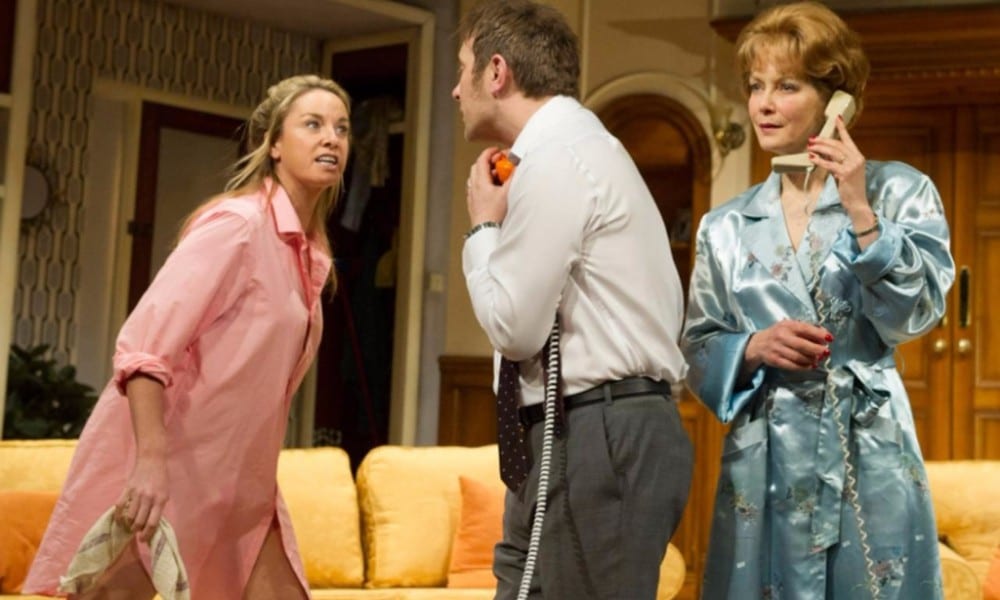Alan Ayckbourn was a thirty-year-old with a, shall we say, unromantic view of marriage when he wrote this exquisitely funny comedy in 1969. The humour is unsentimental, biting, frequently bitter. And in this excellent performance, all is delivered with impressive timing and delightful results.
We see How the Other Half Loves through a brilliant narrative device, allowing the audience to witness the living rooms of both the Fosters and the Phillips at the same time. Fiona and Frank Foster are clearly part of the upper middle class while the other pair, Bob and Teresa Phillips, are lower middle class. Impressively, this fusion of location and time is created without confusing the audience.
It is Thursday morning. The Franks are civil; proper breakfast is served on a tray. Meanwhile over at the Phillips’, Bob asks for tea and is told to get it himself from the kitchen. The air at the Phillips’ is pregnant with frustration, anger, suspicion and disrespect. Totally disinterested in his wife or baby son, Bob complains that the house is dirty and that there’s no food at home. Frank Foster, on the other hand, is affectionate and offers an anniversary gift. But in each household one question hangs unanswered: Frank and Teresa demand to know where their respective other halves were the night before into the wee hours.
We see differences in managing marriage, unhappiness, and males. Teresa is streetwise and does not fall for petty lies. She overcomes emotional pain with a pragmatic solution – head-on confrontation. In contrast, the ‘wise, educated’ upper class Frank is slow off the mark. He needs the streetwise Teresa’s help.
The crescendo is in the dinner parties’ scene. This is a delicious example where time frames overlap. Two separate dinner tables on consecutive evenings merge to illuminate class contrasts by juxtaposition. The tablecloths, the plates and wines and manner of serving them unmask yawning social gaps and keenly observed differences in manners in dealing with personal unhappiness.
Jenny Seagrove as Fiona meticulously and superbly projects the wealthier upper class–concerned with looking respectable, keeping an exemplary house even if devoid of happiness. Tamzin Outhwaite’s Teresa is a fine portrayal of a frustrated young mother who cares little for the house but avidly reads the tabloids, writing letters to the editor that are never published. Her high gloss, bright pink boots and matching dress nearly scream in your face ‘I am a commoner with low taste and no sense of dress code.’ Yet she is burning with energy. She resists the conventional wisdom that a wife’s place is to clean and wait on her husband. Despite the social leaps since the 1950s and 60s, her scenes, perhaps regrettably, did not feel dated. The £5 Bob gives her to buy food may be a sign of the period, but had it been £50, the very same dialogue would apply: the humour has maintained its freshness.
Ayckbourn, rightly, gives Teresa the best lines, something which Outhwaite takes full advantage of, dominating the stage. All other characters are beautifully cast. It’s a pleasure to see Gillian Wright’s Mary Featherstone, dragged in as a safe alibi for Bob, transforming over the course of the play.
The comic tone throughout is brilliant. The terse dialogue transmits acute observations of people and of interactions between couples. For the totality of the experience, we must acknowledge Alan Strachan’s superb direction, Julie Godfrey’s set and costume design together with Jason Taylor’s lighting and the effects of Dan Samson Sound Designer, with his artful use of soundtracks from Elvis ‘Suspicious Minds’ and Tommy Roe’s ‘Dizzy’.
This is a delightful production, which I highly recommend.

